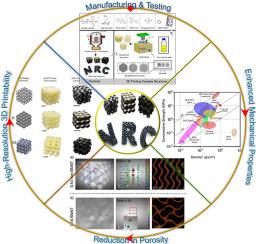3d打印氮化硼纳米管增强聚合物衍生陶瓷,孔隙率降低,强度增强
IF 14.2
1区 材料科学
Q1 ENGINEERING, MULTIDISCIPLINARY
引用次数: 0
摘要
本研究介绍了一种利用氮化硼纳米管(bnnt)增强碳化硅(SiOC)预陶瓷树脂通过数字光处理(DLP)制备陶瓷结构的新方法。这些陶瓷具有复杂的形状和高分辨率的三周期最小表面(TPMS)结构,具有低相对密度结构但致密(低孔隙率)的陶瓷特征。将低浓度(0.2、0.4和0.8 wt%)的bnnt加入到市购的SiOC前驱体中,然后将其配制成用于DLP印刷,从而显著降低了聚合物衍生的SiOC的孔隙率,提高了其机械性能。与基线SiOC晶格相比,这种综合效应以更高的精度保留了原始设计,并显著提高了3d打印陶瓷的能量吸收和抗压强度,分别提高了4.4倍和6倍。表征表明,加入BNNT后,存储模量和损耗模量发生了适度的变化,而BNNT修饰的配方表现出优异的印刷性能,陶瓷密度测量证实,加入BNNT后,陶瓷密度略有增加。这种创新的方法与增材数字化制造的多功能性相结合,可以为航空航天、能源和生物医学应用创建具有可调特性的可定制生物陶瓷结构。本文章由计算机程序翻译,如有差异,请以英文原文为准。

3D-printed boron nitride nanotube-reinforced polymer-derived ceramics with reduced porosity and enhanced strength
This study introduces a novel approach for fabricating ceramic structures using a silicon oxycarbide (SiOC) preceramic resin enhanced with boron nitride nanotubes (BNNTs) through digital light processing (DLP). These ceramics feature intricate shapes and high-resolution triply periodic minimal surface (TPMS) architectures with low relative density structures but dense (low-porosity) ceramic features. Incorporating BNNTs at low concentrations (0.2, 0.4, and 0.8 wt%) into a commercially available SiOC precursor, which was then formulated for DLP printing, resulted in a significant reduction in porosity and improved mechanical performance in the polymer-derived SiOC. This combined effect preserved original designs with higher accuracy and significantly enhanced energy absorption and compressive strength of the 3D-printed ceramics compared to baseline SiOC lattices, by factors of 4.4 and 6 times, respectively. Characterization revealed modest changes in storage and loss moduli with BNNT addition, while the BNNT-modified formulation exhibited excellent printability, and ceramic density measurements confirmed a slight increase with BNNT incorporation. This innovative approach, paired with the versatility of additive digital manufacturing, enables the creation of customizable, bio-inspired ceramic structures with tunable properties for aerospace, energy, and biomedical applications.
求助全文
通过发布文献求助,成功后即可免费获取论文全文。
去求助
来源期刊

Composites Part B: Engineering
工程技术-材料科学:复合
CiteScore
24.40
自引率
11.50%
发文量
784
审稿时长
21 days
期刊介绍:
Composites Part B: Engineering is a journal that publishes impactful research of high quality on composite materials. This research is supported by fundamental mechanics and materials science and engineering approaches. The targeted research can cover a wide range of length scales, ranging from nano to micro and meso, and even to the full product and structure level. The journal specifically focuses on engineering applications that involve high performance composites. These applications can range from low volume and high cost to high volume and low cost composite development.
The main goal of the journal is to provide a platform for the prompt publication of original and high quality research. The emphasis is on design, development, modeling, validation, and manufacturing of engineering details and concepts. The journal welcomes both basic research papers and proposals for review articles. Authors are encouraged to address challenges across various application areas. These areas include, but are not limited to, aerospace, automotive, and other surface transportation. The journal also covers energy-related applications, with a focus on renewable energy. Other application areas include infrastructure, off-shore and maritime projects, health care technology, and recreational products.
 求助内容:
求助内容: 应助结果提醒方式:
应助结果提醒方式:


